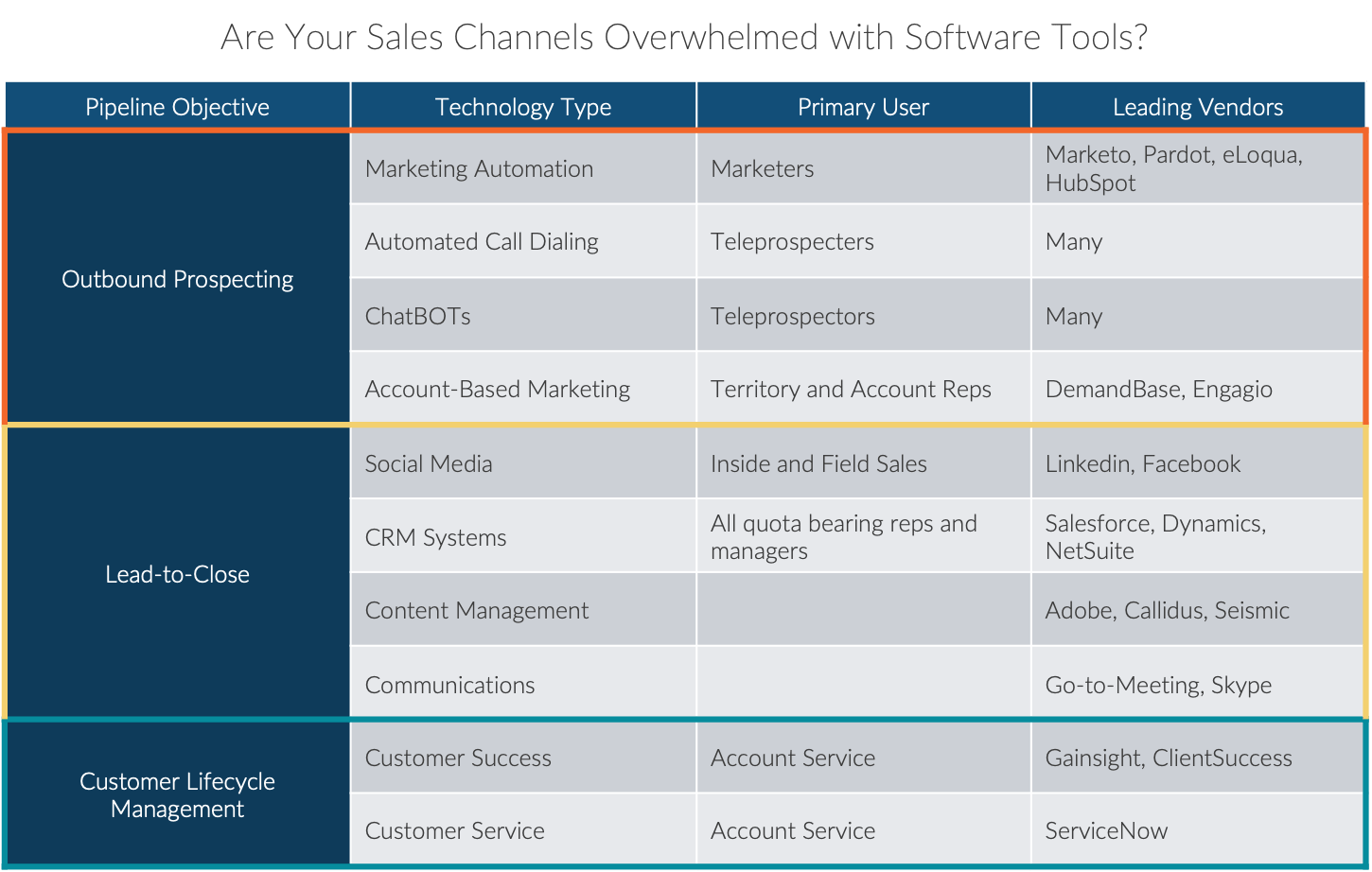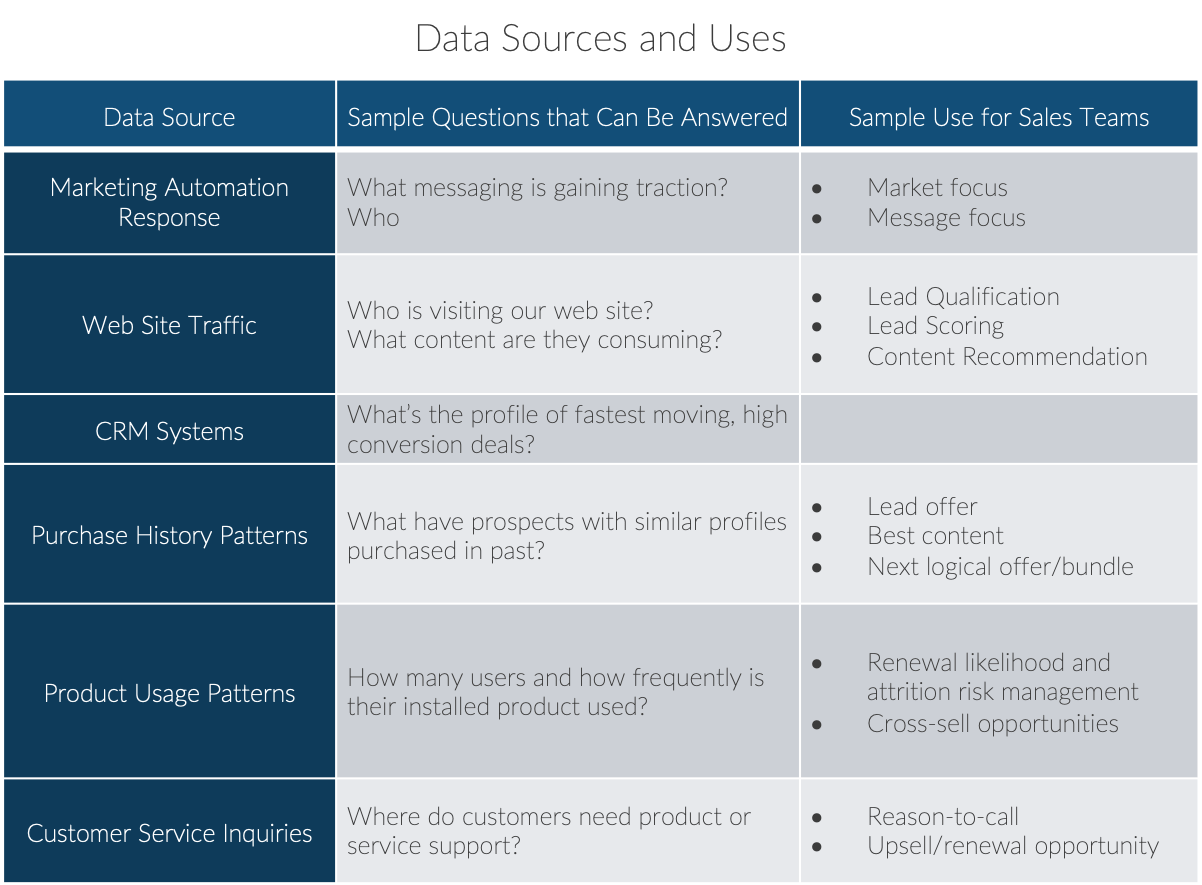What Exactly is Digital Sales Transformation?
As of 2020, “digital transformation” is a hot topic in corporate America. Companies are spending millions of dollars redesigning their front-end customer experience (e.g. search/SEO, marketing automation, web sites, catalogs, order entry systems, customer service portals) and back-end business processes (financial reporting, inventory management, etc.).
But “digital transformation” of a salesforce – actual people – is almost an oxymoron. Yes, we can provide sales reps with more software tools but essentially, they are still managing human-to-human interactions to communicate, educate and sell products. To many, digital sales transformation is largely providing software tools to automate more traditional manual processes including contact profiles (e.g. LinkedIn), marketing automation, CRM pipeline systems, account-based marketing (ABM) software, and content management to name a few.
But companies are realizing that investing more and more in additional “per-seat software licenses” is not having a material impact on sales productivity.
The 5 Pillars of Digital Sales Transformation (DST)
Successful digital sales transformation (DST) is a change that fuels existing and new growth paths and goes beyond simple annual changes in territories, compensation models, and the blanket deployment of new technologies. Rather, it must address five pillars of digital change:
- Understanding Digital Customer Buying Behavior
- Re-Allocating Sales Resources
- Changing Coverage, Quota, and Compensation
- Automating Sales Workflows
- Creating a Data-Driven Sales Transformation
We won’t go into detail on these 5 pillars in this blog, but let’s just touch on each briefly:
Pillar 1: Understanding Digital Customer Buying Behavior
Everyone knows that digital technology is rapidly changing customer buying behavior. But sometimes it seems as if traditional sales models based on geographic territories, face-to-face-meetings, and annual industry conferences just aren’t keeping up with how customers are now buying.
-
Customers May Be Smarter than You:
This is not meant to be offensive! Rather, sales reps must recognize a prospect its likely to have done extensive online research, read many analyst reports, read online peer reviews, and already talked to your competitors. Adding to their ability to “digitally self-educate,” they know their problem better than most sales reps. Because of this, sales actions must be backed with the right predictive buying data to understand what customers have already consumed, and which products and solutions best fit with each buyer persona.
-
Customers Are Spending Less Time with Reps
The days of easily scheduling meetings, having 2-hour lunches and playing 4-hour golf rounds are over. Most customers have more responsibility, less available time. Again, another reason for understanding who is ready to buy, what message/content will resonate, and what offer is optimal for each customer.
-
Customers Expect Expertise from Reps
When a prospect does engage with a rep they expect them to be solution experts, respond quickly, and solve their problem. Plain and simple knowing “who,” “with what,” and “how” to go after each prospect is essential (and the right customer data signals can help with all of this).
In sum, DST must begin with a clear understanding of what added value the customer expects to be delivered from their time investment in a sales rep.
Pillar 2: Re-Allocating Sales Resources & Roles
Today’s sales teams have evolved into several types of “specialists” driving qualified leads to closed deals to lasting relationships. The days of a sales rep managing the full lifecycle of customer engagement are over; the level of expertise demanded at each stage is so high that multiple “selling” resources must work together. As a result, we now see more complex, specialized sales roles than ever, such as:
- Traditional Territory Reps
- New Business Development Reps
- Inside Sales Execs
- Products Specialists
- Account Managers
- Partner Managers
- Customer Success Managers
In a digital sales model, not only do these specific roles need to be defined, recruited, and trained but sales leaders need to do an entirely new type of “capacity planning” to determine how many of each type of rep is needed and where they should be deployed. Again, if customer buying journeys are becoming more digital, then multi-channel sales leaders must respond with a different mix of resources and skills
Pillar 3: Changing Coverage, Quota & Compensation
As implied by Pillar 2, the new digital sales force must work as a team to acquire, nurture, and expand accounts. When IBM moved toward this multi-specialist sales model 10 years ago, they found they needed as much as $5 of quota (across multiple sales resources) to achieve every $1 dollar of the companies recognized revenue. Yes, the double counting and “stacking” of channels continues to increase as customers demand multi-channel coverage and require different specialists at each stage of the customer lifecycle.
The implication is clear – any Digital Sales Transformation requires material changes in:
- What coverage resources are needed to land new customers and achieve long term customer success and retain?
- Who gets revenue credit for what deals, accounts, territories?
- What activity metrics are most important for each type of sales resource?
- How should compensation incentives be designed and managed?
Answering these and other questions can be challenging – but nowhere near as challenging as implementing change across a legacy sales culture. While digital customer buying behavior has changed rapidly, sales reps resist material changes in year-over-year coverage assignments, quota levels, and compensation schemes.
Growth Planning: A Three-Part Model for 2019 and Beyond
“Where will our growth come from over the next three years?” Every strategic planning …
Read MorePillar 4: Automating Sales Workflows
As stated above, the technologies available to improve sales performance are impressive compared to just 5 years ago. Most of the new technology platforms are designed for a specific type of sales resources doing a specific task. The big challenge is that increasingly sales reps have anywhere from 5-10 separate software tools they are asked to use – each one supposedly “doubling” their productivity!
Here is a brief (not exhaustive) overview of the many digital sales technologies and their specific objectives and users:
There are many more digital sales technology categories and software vendors – the point is sales professionals desktops and mobile phones are increasingly crowded with multiple, disconnected apps.
Unfortunately, software vendors too often convince senior execs that “the deployment of our platform across 100 seats will result in 20% sales productivity improvement.” If you’re a golfer, you know that every next-generation driver always claim to add 15 yards your drives – 5 equipment generations and 10 years later you still only hit the ball 250 yards!
The lesson is clear: NO software tool will move the sales effectiveness needle without the right customer strategy (Pillar 1), sales resources (Pillar 2), coverage and incentives (Pillar 3), and lastly the right data (see Pillar 5 below).
Pillar 5: Creating a Data-Driven Sales Transformation
Ultimately, we believe DST is less about “doing things faster” (i.e. automation) than it is about “doing things smarter” (i.e. sales intelligence and predictive analytics). So that takes us to Pillar 5, the core of digital sales transformation – becoming a data-driven, multi-channel sales team that connects with customers at the right time, with the right product/message, through the right channels.
In almost every company, there is an immense and powerful amount of customer data through which to dramatically improve sales productivity.
Without comprising customer privacy or data anonymity, predictive data analytics can enable any sales resource – field sales, inside sales, channel partners, e-commerce platforms -to quickly answer four questions to dramatically improving both targeting effectiveness and lead-to-close conversion rates:
- Who should they target with a high propensity to buy?
- What is this prospect’s preferred engagement channel?
- Which messaging and content will resonate best?
- How can the opportunity be best advanced through each stage of the buying process?
To understand the immense potential in data-driven sales transformation, consider this simplified table of customer data sources and their potential usage in your sales process:
Again, the above “sources and uses” of customer data to drive sales effectiveness is far from exhaustive. But the potential to target prospects, messaging, offers, etc. remains woefully untapped in most companies.
Getting Started by Auditing Your Data in Preparation for Digital Sales Transformation
Making the transition to digital sales is about getting data where it is needed, which (as mentioned earlier) can include—but should not be dominated by—a software solution. Organizations should instead start with a data audit, looking at starting capabilities and gaps. Check out our foundational framework on conducting a data audit for sales transformation here >
Conducting a Data Audit to Prepare for Digital Sales Transformation
There are 7 key traits to establish a strong data foundation that will help …
Read More






